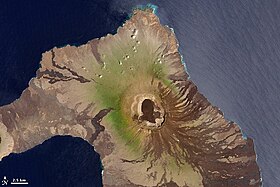Volcan Wolf
| Volcán Wolf | |
|---|---|

Wolf Volcano, 2001, NASA Landsat 7 image
|
|
| Highest point | |
| Elevation | 1,707 m (5,600 ft) |
| Prominence | 1,707 m (5,600 ft) |
| Listing | Ultra |
| Coordinates | 0°02′00″N 91°20′00″W / 0.033333°N 91.333333°WCoordinates: 0°02′00″N 91°20′00″W / 0.033333°N 91.333333°W |
| Geography | |
| Location | Isabela Island, Galapagos Islands |
| Geology | |
| Mountain type | Shield volcano |
| Last eruption | May to June 2015 |
Wolf Volcano (also known as Mount Whiton) is the highest peak in the Galapagos Islands and is situated on Isabela Island and reaches 1,707 m (5,600 ft). It is a shield volcano with a characteristic upturned soup bowl shape.
The volcano was named after Theodor Wolf, a German geologist who studied the Galapagos Islands in the 19th century. Wolf Island in the north of the Galapagos is also named after the geologist.
Its height makes Wolf Volcano an "ultra prominent peak", which is a peak with a topographic prominence of over 1500m.
In a process similar to the formation of the Hawaiian islands, the Galapagos (along with associated hotspot) appear to be created from a mantle plume. This plume stays in place while the Nazca Plate moves above it; the relative movement of this plate is 0.46 degrees per million years. The volcano itself is estimated to be less than half a million years old; the oceanic plate beneath it is theorized to be around 10 million years old.
Wolf is situated at the northern end of Isabela Island in the Galapagos, and sits on the Equator, one of six coalescing volcanoes that make up this island (the others being Ecuador, Darwin, Alcedo, Sierra Negra, and Cerro Azul). Along with the Fernandina Island volcano, the western Galapagos volcanoes have similar structures that differ from the volcanoes in the eastern part of the archipelago. The western volcanoes are higher and have larger calderas than those to the east, they are also shaped like an upturned soup bowl.
...
Wikipedia

